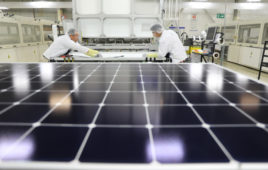By Paul Grana, co-founder, Folsom Labs
Solar engineers and developers are always thinking about shading that could encumber their solar arrays. After all, when your goal is to turn sunlight into money, anything that reduces that sunlight is bad. “Avoid shade” is one of those rules that is easy to say but complicated to deliver. Historically, designers optimize arrays for a specific day and time range—most commonly 10 a.m. to 2 p.m. on the winter solstice. This is especially true for commercial-scale arrays. Having a single day of shading to account for lets system designers model shadows using straightforward rules based on the project latitude. In short, it is a heuristic that can be done largely by hand in CAD:

The process in CAD is straightforward, but that doesn’t make it sound. Increasingly, system designers are looking to shade optimization as a way to improve their system economics, filtering modules based on their actual shade losses. It’s worth digging into a new crop of design rules—and how they are changing solar system designs.
Total shade loss versus solstice loss
Solstice shading, as shown above, is relatively easy to implement. The big downside, however, is that there is nothing magical about that one day of the year. Yes, it is the day where the sun is at its lowest, but that also means that it tends to be one of the least productive days of the year. System designers care about energy for the entire year (or, sunlight, the pre-cursor to energy), but that is not easy to estimate with pencil and paper (or, the CAD/Excel equivalent). Even engineers who look at both the winter and summer solstices, accounting for the two seasons, are still far from calculating the actual sunlight a module receives.
This is why the new standard is to perform shading analysis based on the amount of sunlight that a module gets over an entire year, using tools such as HelioScope. HelioScope combines a 3D model of the array and its surroundings, along with a powerful physics model that also calculates the sun angle and sunlight at each hour of the year. The result is a map of how much (or little) sunlight each module receives – which the designer can use to determine their allowable shade tolerance.

Using advanced design tools, a number of solar engineers have determined that a 10% shade threshold gives them the optimal balance of system size versus yield (a topic that we will revisit later). The optimal shade tolerance for any system will depend on the cost structure, location, and technology used – but for the sake of this article, we will take that 10% shade threshold as optimal, and look at the design implications of these new design rules.
What 10% shade tolerance looks like in practice
The best way to dig into the implications of the new shade optimization approach is to look at them in practice across a variety of applications.
HVAC unit: We start with the example shown above, a commercial building in Colorado with HVAC units. If we first design to 10 a.m. to 2 p.m. shade exclusion on the solstice, we will sacrifice 74 modules (6.4% of the system size). Note that these modules tend to be north of the HVAC units, consistent with the sun being low in the sky on the winter solstice. A 10% shade tolerance is more forgiving of modules that are only shaded in December, and instead tends to remove modules to the east and west of the HVAC units, which are shaded in the summer months (as even the summer morning often has more energy than the winter mid-day). In short, these modules are not getting shaded on the winter solstice, but they are losing enough sunlight in the summer morning and evening to hit the 10% shade threshold for removal. As a result, the system designed with a 10% shade threshold is slightly larger than the traditional system, sacrificing 2.4% fewer modules than the array designed with the solstice rules.

Water Tower: We next look at an array located near a tall water tower. The winter solstice shading removes a significant swath of modules to the north and west of the water tower. Again, this removal is driven by the position of the sun at 10 a.m. on December 21. However, the overall shade intensity is concentrated more to the west of the water tower (driven by the intensity of the sunlight in the summer versus the winter). This is another case where the modules shaded on the winter solstice actually have fairly low overall shade losses over the course of the year. The shade-optimized design is notably larger in this application, coming in at 957 kW versus 883 kW for the winter solstice, an increase of 8%.

Tree line: We finish by looking at a very different shade profile: a tall tree line near a ground-mounted array. This design results in the most dramatic difference between the winter solstice shade exclusions and the 10% shade threshold. The shade threshold rules make the system 29% larger, an increase of more than 200 kW. As with the other designs, the shade-optimized design here brings back the modules that are only shaded in the winter months, but is more conservative regarding shade during summer. This can be seen in the added modules in the south part of the array and the additional removed modules along the eastern edge.

The new shape of solar design
The winter solstice design rule leads to conservative system designs, and it can still lead to fairly significant shading in the summer months. By switching to a shade optimization approach that considers the entire year, system designers can deliver larger systems that are more productive. Particularly when an array is shaded significantly during the winter months, modules that would traditionally be removed are often profitable to add back into the system. Designers and engineers who do not use modern software tools like HelioScope to analyze these decisions are often leaving money on the table.
Read more Solar Boot-up articles from Folsom Labs here.




Shade optimization would definitely lead to a better and more efficient year-round solar energy system. Predictive analysis is proving to be of great use even in the solar tech industry.
An important factor that is not touched on in this article is the usage of inverters. Impact of shading on central inverter vs. string inverters vs. micro/optimizer is different.
By using a panel level optimizer, partial shading has a lower impact on the system IRR. One can calculate what the minimal production per module has to be to provide a positive return for that specific module. The impact of partial shading on a string of 17 modules, where the shaded panel might reduce the production of the entire string is more drastic.
If Helioscope could provide an estimate per module in terms how many kWh a specific module would produce in the shaded area, that would be a great tool for designers to use.
Overall, in full agreement to get away from Dec 21 10am to 2pm shading pattern. Here in Ontario, Canada most rooftop projects will be covered with snow anyways 🙂
This is a good tool, but does not take into account another significant factor, which is cost of deployment versus benefit derived. For instance, putting two modules on a segregated ballast mount row that will require new conductor runs, increased racking wind requirements, obtrusive conduit passages, etc., while having marginalized production, is much less desirable than extending a ground mount into a suboptimal shade impacted zone. As array pricing decreases, your 10% will again become overly conservative. Additionally, time of production is increasingly important, and creating an hourly profile of production will have an impact, which could mitigate shading impact. Overall, I really appreciate the production of these kinds of efforts, but while rules of thumb can be very useful, especially for those of us in non utility scale, it is sometimes too easy to rely on them, at the expense of our clients.
I was previously happy with HelioScopes shading tools when using the plug in with SketchUp. What you are describing here makes it a much better tool for the computations and layout design.